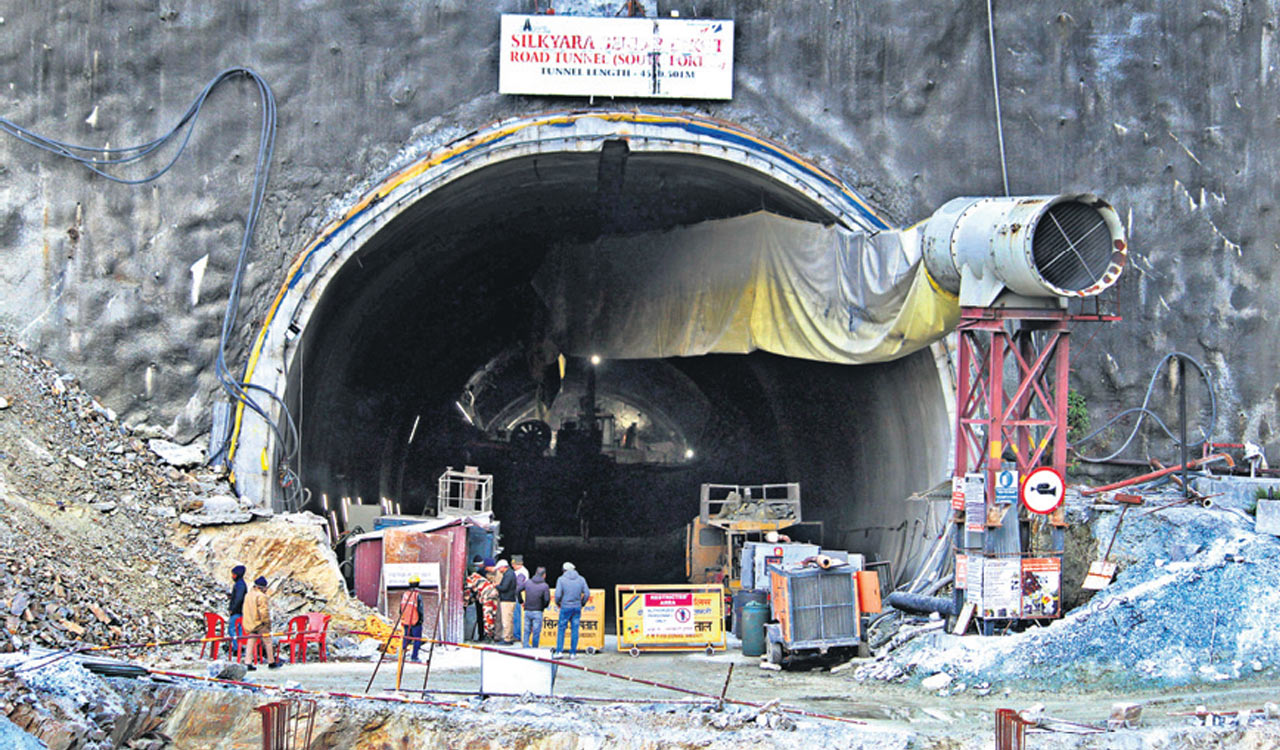Uttarkashi tunnel tragedy highlights the need to have a development model that embraces resilience
Published Date – 11:30 PM, Fri – 17 November 23

By PK Joshi
Fostering infrastructure development in the Himalayan region, the world’s most formidable mountain range, holds paramount importance. Such development not only acts as a catalyst for economic growth but also plays a pivotal role in ensuring the well-being of the local population, encompassing aspects like education and healthcare.
Moreover, it is instrumental in preserving the environment and cultural heritage, improving connectivity and addressing strategic challenges imposed by the region’s unique geography and the impacts of climate change. Nevertheless, the key to sustainable infrastructure development lies in the incorporation of environmentally friendly technologies to minimise adverse effects on these fragile ecosystems.
Stark Reminder
The Uttarkashi tunnel collapse, being built by National Highways and Infrastructure Development Corporation Limited (NHIDCL), has reverberated throughout the nation, serving as a stark reminder of the vulnerability of infrastructure in this challenging terrain. The tunnel, conceived as a solution to enhance accessibility to remote areas in Uttarakhand, represents an ambitious undertaking aimed at mitigating the challenges posed by harsh weather conditions and difficult topography. Spanning between Silkyara and Dandalgaon on the Brahmakhal-Yamunotri National Highway, the tunnel project underscores the need for development in the Himalayan region.
As per the information received from the District Emergency Operations Centre in Uttarkashi, a segment of the under-construction transport tunnel on the Dharasu-Barkot corridor, measuring 4,531 metres in length, collapsed on November 12. The tunnel excavation had progressed to 2,340 metres from Silkyara and 1,750 metres from Barkot, with the collapse occurring approximately 270 metres from Silkyara. The affected area spans around 40 metres. Reportedly, 40 individuals are trapped inside the tunnel. Rescue operations have been going on.
There has been a successful restoration of oxygen supply in the affected area using a water pipe, and ongoing endeavours are focused on reinstating the supply of other essentials. Physical interventions include mobilisation of shotcrete machines for efficient muck removal. Additionally, various agencies and response units are mobilising necessary resources to facilitate the rescue operation. The collaborative response demonstrates a commitment to addressing the immediate challenges and mitigating the impact of the incident through coordinated efforts at both the State and national levels.
Human Interventions
Throughout history, human interventions in the Himalayas have yielded substantial environmental impacts. The first notable changes occurred during the period of British colonisation, marked by alterations in administration, land ownership and tenure arrangements aimed at economic exploitation. These shifts not only led to ecological consequences but also contributed to cultural erosion.
A pivotal intervention unfolded in the 1870s when Sir Arthur Thomas Cotton proposed the construction of a series of canals connecting Himalayan rivers to the southern tip of India. Post-independence, this pattern persisted, driven by a complex interplay of environmental, social and economic factors. The influence of American engineers and their Soviet counterparts, coupled with financial support from the World Bank, propelled the construction of dams. This developmental trajectory endures, characterised by the continuous widening of roads, the proliferation of concrete structures, and an annual influx of an increasing number of tourists.
Consequently, the supporting infrastructure for these economic activities continues to expand. This historical continuum illustrates the lasting impact of human interventions in the region’s environment and highlights the multifaceted dynamics of development shaped by diverse influences over time.
Responsible Development
The recent incidents in Joshimath, Himachal Pradesh, Teesta River and others underscore the urgent need for a comprehensive re-evaluation of development strategies in ecologically sensitive regions. It is crucial to analyse the contributing factors to these catastrophic events, not only to prevent future disasters but also to ensure the safety of the residents in these areas. Balancing the imperative for connectivity and economic development with environmental conservation presents a delicate challenge.
Recognising this imperative, in September 2023, the central government urged the Supreme Court to direct 13 Himalayan States/UTs to assess their carrying capacity and formulate a time-bound action plan. Several States have already initiated this process, actively identifying and involving expert committees. This proactive approach demonstrates a commitment to responsible development and highlights the significance of integrating environmental considerations and safety measures into the planning and execution of projects in the Himalayas.
When undertaking the construction of critical infrastructure in these areas, a thorough understanding of the rock formations, fault lines and potential instability zones is imperative. In particular, initiatives in the Himalayan region should not compromise on leveraging available technology. For instance, advanced technologies like ground-penetrating radar and seismic imaging are essential for comprehending complex geology. Construction projects must include real-time monitoring systems to promptly detect any structural abnormalities or shifts in geological conditions during and after construction.
Exploring alternative construction methods, such as elevated or suspended structures, becomes crucial in order to minimise extensive excavation and tunnelling, especially in fragile areas. The region must transcend mere adherence to sustainable development principles and instead invest in fail-safe design features and practices.
Situated at an elevation where the forces of nature are unpredictable and often unforgiving, the Himalayan region necessitates an engineering prowess that surpasses conventional standards. Fail-safe engineering, designed to respond minimally or with zero harm in the event of a specific type of failure, becomes crucial given the precarious nature of the environment.
Learning from Setbacks
As climate change-induced hazards escalate in intensity and frequency, a proactive approach involving both adaptation and mitigation is imperative. The strategies employed should be inherently people-centric, demonstrating sensitivity and appropriateness to the unique Himalayan landscape. Furthermore, engaging local communities in the planning and decision-making processes becomes integral, tapping into their nature-embedded traditional knowledge of the terrain. This inclusive approach not only addresses the concerns of the local population but also ensures that development initiatives are harmoniously aligned with the intricacies of the Himalayan ecosystem.
Moreover, in these terrains, where accessibility is inherently challenging even under routine conditions, the need for prompt and efficient yet tailored rescue operations becomes particularly evident. Enhancing disaster management protocols becomes imperative, and providing local authorities with the requisite resources and training is pivotal for facilitating a swift response to unforeseen events. To bolster preparedness, the local administration should establish well-equipped emergency response centres strategically positioned to enable rapid deployment in the event of disasters. This proactive approach not only ensures a more effective response but also addresses the unique challenges posed by the geographical intricacies of mountainous regions.
The process of development must not follow a one-size-fits-all approach; instead, it is a journey shaped by learning from our setbacks. The need of the hour is a development model that embraces resilience, particularly one that is centred around both the well-being of individuals and the integration of local settings. Such a model should not only acknowledge the inevitability of failures but also leverage them as opportunities for growth, ultimately fostering a sustainable and adaptive approach to development. (Views are personal)






